Expansion of Coccidioidomycosis Endemic Regions in the United States in Response to Climate Change
- PMID: 32159021
- PMCID: PMC7007157
- DOI: 10.1029/2019GH000209
Expansion of Coccidioidomycosis Endemic Regions in the United States in Response to Climate Change
Abstract
Coccidioidomycosis (Valley fever) is a fungal disease endemic to the southwestern United States. Across this region, temperature and precipitation influence the extent of the endemic region and number of Valley fever cases. Climate projections for the western United States indicate that temperatures will increase and precipitation patterns will shift, which may alter disease dynamics. We estimated the area potentially endemic to Valley fever using a climate niche model derived from contemporary climate and disease incidence data. We then used our model with projections of climate from Earth system models to assess how endemic areas will change during the 21st century. By 2100 in a high warming scenario, our model predicts that the area of climate-limited endemicity will more than double, the number of affected states will increase from 12 to 17, and the number of Valley fever cases will increase by 50%. The Valley fever endemic region will expand north into dry western states, including Idaho, Wyoming, Montana, Nebraska, South Dakota, and North Dakota. Precipitation will limit the disease from spreading into states farther east and along the central and northern Pacific coast. This is the first quantitative estimate of how climate change may influence Valley fever in the United States. Our predictive model of Valley fever endemicity may provide guidance to public health officials to establish disease surveillance programs and design mitigation efforts to limit the impacts of this disease.
Keywords: Coccidioidomycosis; Valley fever; human health; infectious diseases; mycoses; niche model.
©2019. The Authors.
Conflict of interest statement
The authors declare no conflicts of interest relevant to this study.
Figures
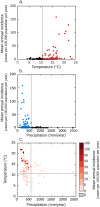

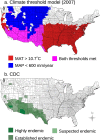
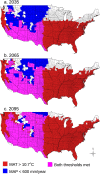

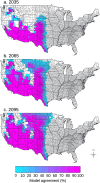
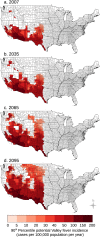
References
-
- Baptista‐Rosas, R. C. , Catalán‐Dibene, J. , Romero‐Olivares, A. L. , Hinojosa, A. , Cavazos, T. , & Riquelme, M. (2012). Molecular detection of Coccidioides spp. from environmental samples in Baja California: Linking Valley Fever to soil and climate conditions. Fungal Ecology, 5(2), 177–190. 10.1016/j.funeco.2011.08.004 - DOI
-
- Barker, B. M. (2018). Coccidioidomycosis in animals In Seyedmousavi S., de Hoog G., Guillot J., & Verweij P. (Eds.), Emerging and Epizootic Fungal Infections in Animals, (pp. 81–114). Cham: Springer; 10.1007/978-3-319-72093-7_4 - DOI
